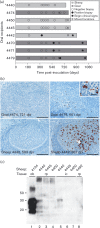The placenta shed from goats with classical scrapie is infectious to goat kids and lambs
- PMID: 25888622
- PMCID: PMC4681073
- DOI: 10.1099/vir.0.000151
The placenta shed from goats with classical scrapie is infectious to goat kids and lambs
Abstract
The placenta of domestic sheep plays a key role in horizontal transmission of classical scrapie. Domestic goats are frequently raised with sheep and are susceptible to classical scrapie, yet potential routes of transmission from goats to sheep are not fully defined. Sparse accumulation of disease-associated prion protein in cotyledons casts doubt about the role of the goat's placenta. Thus, relevant to mixed-herd management and scrapie-eradication efforts worldwide, we determined if the goat's placenta contains prions orally infectious to goat kids and lambs. A pooled cotyledon homogenate, prepared from the shed placenta of a goat with naturally acquired classical scrapie disease, was used to orally inoculate scrapie-naïve prion genotype-matched goat kids and scrapie-susceptible lambs raised separately in a scrapie-free environment. Transmission was detected in all four goats and in two of four sheep, which importantly identifies the goat's placenta as a risk for horizontal transmission to sheep and other goats.
Figures


References
-
- Andréoletti O., Lacroux C., Chabert A., Monnereau L., Tabouret G., Lantier F., Berthon P., Eychenne F., Lafond-Benestad S., other authors (2002). PrP(Sc) accumulation in placentas of ewes exposed to natural scrapie: influence of foetal PrP genotype and effect on ewe-to-lamb transmission J Gen Virol 83 2607–2616. - PubMed
Publication types
MeSH terms
Substances
LinkOut - more resources
Full Text Sources
Other Literature Sources

